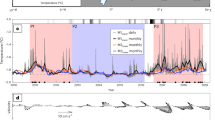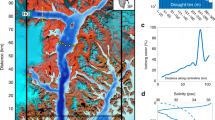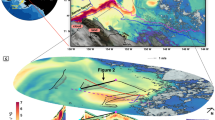Abstract
The recent rapid increase in mass loss from the Greenland ice sheet1,2 is primarily attributed to an acceleration of outlet glaciers3,4,5. One possible cause of this acceleration is increased melting at the ice–ocean interface6,7, driven by the synchronous warming8,9,10 of subtropical waters offshore of Greenland. However, because of the lack of observations from Greenland’s glacial fjords and our limited understanding of their dynamics, this hypothesis is largely untested. Here we present oceanographic data collected in Sermilik Fjord, East Greenland, by ship in summer 2008 and from moorings. Our data reveal the presence of subtropical waters throughout the fjord. These waters are continuously replenished through a wind-driven exchange with the shelf, where they are present all year. The temperature and renewal of these waters indicate that they currently cause enhanced submarine melting at the glacier terminus. Key controls on the melting rate are the volume and properties of the subtropical waters on the shelf, and the patterns of along-shore winds, suggesting that the glaciers’ acceleration has been triggered by a combination of atmospheric and oceanic changes. Our measurements provide evidence for a rapid advective pathway for the transmission of oceanic variability to the ice-sheet margins.
This is a preview of subscription content, access via your institution
Access options
Subscribe to this journal
Receive 12 print issues and online access
$259.00 per year
only $21.58 per issue
Buy this article
- Purchase on Springer Link
- Instant access to full article PDF
Prices may be subject to local taxes which are calculated during checkout




Similar content being viewed by others
References
Rignot, E. & Kanagaratnam, P. Changes in the velocity structure of the Greenland ice sheet. Science 311, 986–990 (2006).
Velicogna, I. Increasing rates of ice mass loss from the Greenland and Antarctic ice sheets revealed by GRACE. Geophys. Res. Lett. 36, L19503 (2009).
Stearns, L. A. & Hamilton, G. S. Rapid volume loss from two East Greenland outlet glaciers quantified using repeat stereo satellite imagery. Geophys. Res. Lett. 34, L05503 (2007).
Howat, I. M., Joughin, I. & Scambos, T. A. Rapid changes in ice discharge from Greenland Outlet Glaciers. Science 315, 1559–1561 (2007).
Joughin, I., Abdalati, W. & Fahnestock, M. Large fluctuations in speed on Greenland’s Jakobshavn Isbræ glacier. Nature 432, 608–610 (2004).
Thomas, R. H. Force-perturbation analysis of recent thinning and acceleration of Jakobshavn Isbræ, Greenland. J. Glaciol. 50, 57–66 (2004).
Nick, F. M., Vieli, A., Howat, I., M. & Joughin, I. Large-scale changes in Greenland outlet glacier dynamics triggered at the terminus. Nature Geosci. 2, 110–114 (2009).
Myers, P. G., Kulan, N. & Ribergaard, M. H. Irminger Water variability in the West Greenland Current. Geophys. Res. Lett. 34, L17601 (2007).
Bersch, M., Yashayaev, I. & Koltermann, K. P. Recent changes of the thermohaline circulation in the Subpolar North Atlantic. Ocean Dyn. 57, 223–235 (2007).
Thierry, V., de Boisséson, E. & Mercier, H. Interannual variability of the Subpolar Mode Water properties over the Rejkyanes Ridge during 1990–2006. J. Geophys. Res. 113, C04016 (2008).
Bindschadler, R. Hitting the ice sheet where it hurts. Science 311, 1720–1721 (2006).
Holland, D. M., Thomas, R. H., De Young, B., Ribergaard, M. H. & Lyberth, B. Acceleration of Jakboshavn Isbræ triggered by warm subsurface ocean waters. Nature Geosci. 1, 659–664 (2008).
Hanna, E. et al. Hydrologic response of the Greenland ice sheet: The role of oceanographic warming. Hydrol. Process. 23, 7–30 (2009).
Bacon, S., Myers, P. G., Rudels, B. & Sutherland, D. A. in Arctic–Subarctic Ocean Fluxes: Defining the Role of the Northern Seas in Climate (eds Dickson, R., Meincke, J. & Rhines, P.) 703–722 (Springer, 2008).
Azetsu-Scott, K. & Tan, F. C. Oxygen isotope studies from Iceland to an East Greenland Fjord: Behaviour of glacial meltwater plume. Mar. Chem. 56, 239–251 (1997).
Sutherland, D. A. & Pickart, R. S. The East Greenland Coastal Current: Structure, variability, and forcing. Prog. Oceanogr. 78, 58–77 (2008).
Kalnay, E. et al. The NMC/NCAR 40-Year Reanalysis Project. Bull. Am. Meteorol. Soc. 77, 437–471 (1996).
Lydersen, C., Nøst, O. A., Kovacs, K. M. & Fedak, M. A. Temperature data from Norwegian and Russian Waters of the northern Barents Sea collected by free-living ringed seals. J. Mar. Syst. 46, 99–108 (2004).
Andersen, J. M., Wiersma, Y. F., Stenson, G. B., Hammill, M. O. & Rosing-Asvid, A. Movement patterns of Hooded seals (Cystophora cristata) in the Northwest Atlantic Ocean during the post-moult and pre-breed seasons. J. Northw. Atl. Fish. Sci. 42, 1–11 (2009).
Klinck, J. M., O’Brien, J. J. & Svendsen, H. A simple model of fjord and coastal circulation interaction. J. Phys. Ocean 11, 1612–1626 (1981).
Stigebrandt, A. On the response of the horizontal mean vertical density distribution in a fjord to low-frequency density fluctuations in the coastal water. Tellus A 42, 605–614 (1990).
Moore, G. W. K. & Renfrew, I. A. Tip jets and barrier winds: A QuickSCAT climatology of high wind speed events around Greenland. J. Clim. 18, 3713–3725 (2005).
Thomas, R. et al. Substantial thinning of a major east Greenland outlet glacier. Geophys. Res. Lett. 27, 1291–1295 (2000).
Roberts, D. H., Long, A. J., Schnabel, C., Freeman, S. & Simpson, M. J. R. The deglacial history of southeast sector of the Greenland ice sheet during the Last Glacial Maximum. Quat. Sci. Rev. 27, 1505–1516 (2008).
Aure, J., Molvær, J. & Stigebrandt, A. Observations of inshore water exchange forced by a fluctuating offshore density field. Mar. Pollut. Bull. 33, 112–119 (1997).
Häkkinen, S. & Rhines, P. B. Decline of Subpolar North Atlantic Circulation during the 1990s. Science 304, 555–559 (2004).
Häkkinen, S. & Rhines, P. B. Shifting surface currents in the northern North Atlantic Ocean. J. Geophys. Res. 114, C04005 (2009).
Acknowledgements
We thank J. Ryder and A. Jorgensen for support in the field work, J. Kemp for logistic support, D. Torres, K. Newhall, S. Worrilow and A. Newhall for instrument preparation, R. S. Pickart. S. Lentz and R. Curry for discussions and Greenpeace International and the crew of the Arctic Sunrise for support in 2009 mooring recovery. F.S. acknowledges support from WHOI’s Ocean and Climate Change Institute’s Arctic Research Initiative and from NSF OCE 0751896, and G.S.H. and L.A.S. from NASA’s Cryospheric Sciences Program. Funding for the hooded seal deployments was obtained from the International Governance and Atlantic Seal Research Program, Fisheries and Oceans, Canada, to G.B.S. and from the Greenland Institute of Natural Resources to A.R.-A.
Author information
Authors and Affiliations
Contributions
F.S. and G.S.H. conceived the study, F.S., D.A.S., L.A.S. and G.S.H. participated in the collection of oceanographic data in Sermilik Fjord, and F.S. and D.A.S. were responsible for the analysis. M.O.H., G.B.S. and A.R.-A. were responsible for the capture of the seals and deployment of the transmitter and F.D. for processing the data from the seals.
Corresponding authors
Ethics declarations
Competing interests
The authors declare no competing financial interests.
Supplementary information
Supplementary Information
Supplementary Information (PDF 951 kb)
Rights and permissions
About this article
Cite this article
Straneo, F., Hamilton, G., Sutherland, D. et al. Rapid circulation of warm subtropical waters in a major glacial fjord in East Greenland. Nature Geosci 3, 182–186 (2010). https://doi.org/10.1038/ngeo764
Received:
Accepted:
Published:
Issue Date:
DOI: https://doi.org/10.1038/ngeo764
This article is cited by
-
Rapid disintegration and weakening of ice shelves in North Greenland
Nature Communications (2023)
-
Iceberg melting substantially modifies oceanic heat flux towards a major Greenlandic tidewater glacier
Nature Communications (2020)
-
Nutrient release to oceans from buoyancy-driven upwelling at Greenland tidewater glaciers
Nature Geoscience (2019)
-
On the variability of the Atlantic meridional overturning circulation transports in coupled CMIP5 simulations
Climate Dynamics (2019)
-
The Holocene retreat dynamics and stability of Petermann Glacier in northwest Greenland
Nature Communications (2018)



